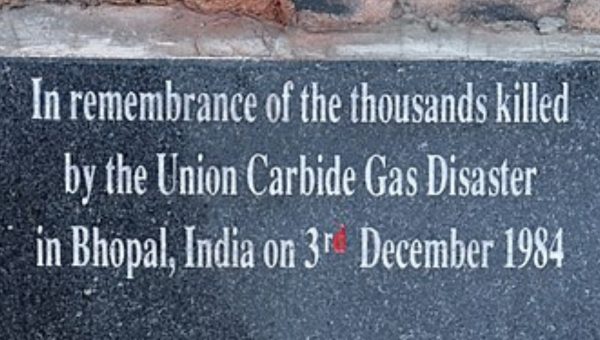05
Jul
Long-Term Impacts on Babies in the Womb during the Bhopal Gas Disaster, Study Reveals

(Beyond Pesticides, July 5, 2023) After nearly 40 years since the Bhopal, India manufacturing facility leaked 47 tons of a chemical used in pesticide production, exposing half a million people and killing thousands, a new study in the BMJ Medical Journal has shed light on the enduring health and human capital effects resulting from in-utero exposure. The study finds significant negative impacts on both economic and health outcomes. Individuals who were in the womb during the disaster exhibited lower birth weights and remain more susceptible to respiratory problems, cognitive impairments, and other health issues later in life. Moreover, those born just after the gas leak were found to have lower educational attainment and reduced earning potential as adults. Over the past four decades, Beyond Pesticides has consistently reported on the Bhopal Gas Disaster, which stands as one of the most devastating industrial tragedies in history [1] [2] [3] [4].
The calamitous night of December 2, 1984, resulted from a gas leak of the highly toxic methyl isocyanate (MIC) from a Union Carbide Corporation (now owned by Dow Chemical Company) manufacturing facility. MIC is an intermediate chemical used in the production of insecticides such as carbaryl (Sevin), aldicarb, and other carbamate pesticides, which are still sold in the United States today. That night in Bhopal, residents living miles away from the site still vividly recall the scene: waking up suffocating, witnessing scenes of chaos, and fleeing through streets filled with lifeless bodies.
While several instances of safety violations contributed to the gas leak, activists often point to the underlying issue—the overwhelming demand for pesticides and industrial chemicals that are unnecessary for effective pest management. Initially, the Indian government reported a death toll of 3,500 within the first few days of the disaster. However, international organizations like Amnesty International claim the number of fatalities to be between 7,000 and 10,000 in the immediate aftermath. Eyewitness testimonies, such as that of Mohammed Karim, who helped handle the bodies in Bhopal, challenge the government’s reported death toll. Karim asserts that 15,000 to 20,000 people lost their lives in the initial days of the disaster. He substantiates his claims by estimating that his team buried around 4,800 bodies per day for four days, with military trucks subsequently disposing of them in the Narmada River.
For those who survived the gas leak, many still experience impacts on their health and their children’s health. This study investigated the causal relationship using spatial difference-in-difference analysis, a well-established method for inferring causality. It examines the effects on adults who were exposed to the Bhopal Gas Disaster while in the womb. The research yields notable findings, including a significant difference in the sex ratio among the 1,260 babies born within 100 km of the gas leak site in 1985, as compared to those born between 1981 and 1984. Additionally, individuals who were in utero during the gas leak and lived near Bhopal exhibit significantly higher rates of cancer in adulthood compared to the cohort living further from Bhopal and the group born before the disaster. Lastly, the study examines differences in male unemployment patterns. Men born in 1985 (in utero during 1984) and residing within 100 km of Bhopal are one percent more likely to report unemployment disability compared to older cohorts. Moreover, men living within 50 km of Bhopal have a two percent higher likelihood of reporting unemployment.
The Bhopal Gas Disaster serves as a stark reminder of the hazards posed by the petrochemical industry, including the production and use of synthetic pesticides and fertilizers. Many advocates firmly believe that eliminating the supply and demand for toxic petrochemical chemicals is the only way to prevent industrial disasters, like Bhopal, as well as other threats to human health, wildlife, and ecosystems. Jay Feldman, the executive director of Beyond Pesticides, emphasized, “The Bhopal Gas Disaster is a tragic consequence of the aggressive promotion and use of hazardous pesticides. Four decades later, the disaster remains etched in our movement’s collective consciousness and underscores the urgent need to eliminate petrochemical pesticides and fertilizers. Beyond Pesticides, along with our coalition partners, is leading the way by implementing organic land management practices and promoting the transition to organic in 60 communities across the United States.”
As the legacy of the Bhopal Gas Disaster lives on, Beyond Pesticides remains committed to preventing similar environmental and human catastrophes through a just transition to organic practices and the elimination of hazardous chemicals. Tell Congress to eliminate future Bhopal disasters by passing an Organic Green New Deal.
Advance organic management practices to replace dependence on chemical-intensive land and building management practices. See Beyond Pesticides’ ManageSafe webpage for information nontoxic management of unwanted plants and insects. Also see, information on transition to organic agriculture and Parks for a Sustainable Future for action steps to achieving a future no longer reliant of petrochemical pesticides and fertilizers.
All unattributed positions and opinions in this piece are those of Beyond Pesticides.
Source: BMJ Medical JournalÂ










